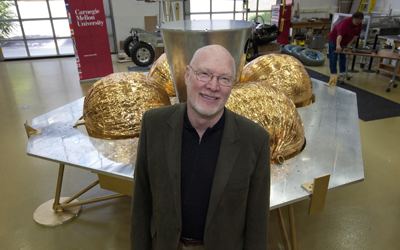Name Red Whittaker Role Professor | ||
 | ||
Alma mater Princeton UniversityCarnegie Mellon University Education | ||
Organizations founded Astrobotic Technology | ||
Red whittaker founding father of robotics talks about the future possibilities of robotics
Red Whittaker is a roboticist and research professor of robotics at Carnegie Mellon University. He led Tartan Racing to its first-place victory in the DARPA Grand Challenge (2007) Urban Challenge and brought Carnegie Mellon University the two million dollar prize. Previously, Whittaker also competed for the DARPA Grand Challenge placing second and third place simultaneously, in the Grand Challenge Races.
Contents
- Red whittaker founding father of robotics talks about the future possibilities of robotics
- Nrec 20th anniversary robots for the high frontier red whittaker robotics institute scs cmu
- Biography
- Robotics
- DARPA Grand Challenge
- Professional activities
- Awards and honors
- References

Whittaker is currently the Fredkin Research Professor at Carnegie Mellon University's Robotics Institute as well as the Director of the Field Robotics Center and Chief Scientist of the Robotics Engineering Consortium, both located at the university.

He is also leading the CMU team which is competing for the Google Lunar X Prize. As the Chairman and CSO of Astrobotic Technology, Whittaker will play an instrumental role in further lunar development.

Nrec 20th anniversary robots for the high frontier red whittaker robotics institute scs cmu
Biography

Whittaker spent his childhood in Hollidaysburg, Pennsylvania, where his father was a salesman for explosives and his mother was a chemist. He matriculated at Princeton University, but interrupted his studies to join the United States Marines. He returned to Princeton to earn his bachelor's degree in civil engineering in 1973 and then attended Carnegie Mellon University, where he earned his master's degree in 1975 and his Ph.D. in 1979, both in civil engineering.
Robotics
In March of the year he received his Ph.D., the nuclear reactor at nearby Three Mile Island nearly experienced a meltdown. Within a budget of $1.5 million, Whittaker and his colleagues at Carnegie Mellon built robots to inspect and perform repairs in the reactor's damaged basement, and their experiences with that project resulted in the creation of the Field Robotics Center at Carnegie Mellon University. Whittaker's later teams would also develop robots to help with the aftermath of the nuclear reactor accident at Chernobyl in 1986. In 1987, Whittaker co-founded RedZone Robotics to develop and sell (or lease) robots that could operate in hazardous environments and situations too dangerous for humans.
Whittaker has led teams that have created robots designed to search for fallen meteorites in the ice fields of Antarctica, climb into the craters of active volcanoes in Alaska and Antarctica, and explore the terrain of Mars. The accident at the Quecreek Coal Mine in nearby Somerset County, Pennsylvania compelled Whittaker and his colleague Scott Thayer to develop robots that could map collapsed or abandoned mines for accident prevention or rescue purposes; they were joined in this endeavor by CMU colleague Sebastian Thrun. Whittaker's robots have also explored the Atacama Desert.
DARPA Grand Challenge
Whittaker has led teams at Carnegie Mellon to build self-driving cars that have participated in the DARPA Grand Challenge since the inception of the contest. In the first competition held in 2004, his Red Team's vehicle "Sandstorm" traveled 7.4 miles, the farthest of any participant, but no prize was awarded to any team. In the second competition in 2005, Whittaker led two teams, whose vehicles "Sandstorm" and "H1ghlander" captured 2nd place and 3rd place, respectively, behind the vehicle of his colleague, former Carnegie Mellon professor Sebastian Thrun. (Thrun's software development leader, Michael Montemerlo, was also a former student of Whittaker.)
In the third competition held in 2007, Whittaker's team "Tartan Racing" captured first place with their vehicle "Boss", winning the $2 million prize.
